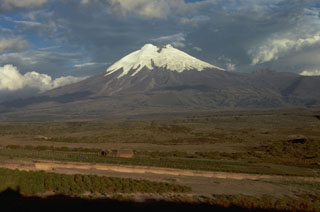Report on Cotopaxi (Ecuador) — 10 June-16 June 2015
Smithsonian Institution / US Geological Survey
Weekly Volcanic Activity Report, 10 June-16 June 2015
Managing Editor: Sally Sennert.
Please cite this report as:
Global Volcanism Program, 2015. Report on Cotopaxi (Ecuador) (Sennert, S, ed.). Weekly Volcanic Activity Report, 10 June-16 June 2015. Smithsonian Institution and US Geological Survey.
Cotopaxi
Ecuador
0.677°S, 78.436°W; summit elev. 5911 m
All times are local (unless otherwise noted)
On 11 June IG reported that seismicity at Cotopaxi continued to increase. Tremor began to be detected on 4 June, with periods ranging from 10 to 15 minutes. Amplitudes were highest during 5-6 June. Sulfur dioxide emissions continued to be elevated over baseline levels (which were less than 500 tons/day), detected at values greater than 2,500 tons/day. Low-energy, pulsating gas emissions began on 10 June, and Cotopaxi National Park staff reported an increase of water flow in some streams on the NE flank.
Geological Summary. The symmetrical, glacier-covered, Cotopaxi stratovolcano is Ecuador's most well-known volcano and one of its most active. The steep-sided cone is capped by nested summit craters, the largest of which is about 550 x 800 m in diameter. Deep valleys scoured by lahars radiate from the summit of the andesitic volcano, and large andesitic lava flows extend to its base. The modern edifice has been constructed since a major collapse sometime prior to about 5,000 years ago. Pyroclastic flows (often confused in historical accounts with lava flows) have accompanied many explosive eruptions, and lahars have frequently devastated adjacent valleys. Strong eruptions took place in 1744, 1768, and 1877. Pyroclastic flows descended all sides of the volcano in 1877, and lahars traveled more than 100 km into the Pacific Ocean and western Amazon basin. Smaller eruptions have been frequent since that time.
Source: Instituto Geofísico-Escuela Politécnica Nacional (IG-EPN)

